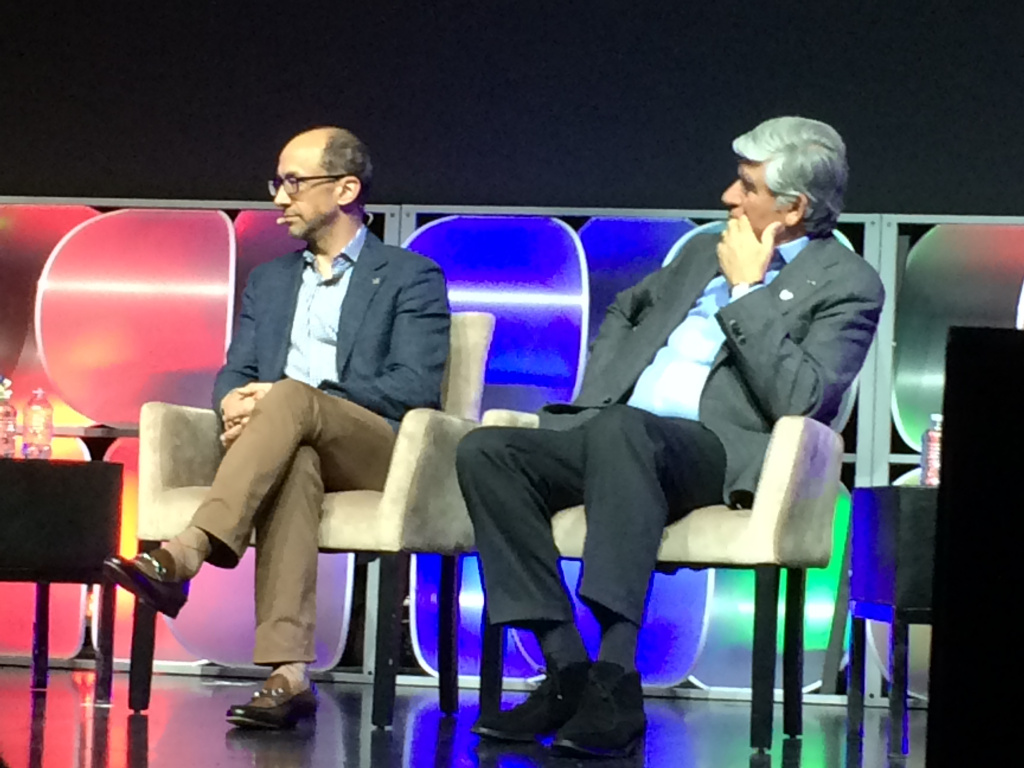

Dick Costolo, the CEO of Twitter, says that it’s easy enough for consumers to opt out of tailored ads on Twitter, but he does not know how many actually go through the process of doing so. “You can opt out of tailored ads and content,” he told an audience today. But asked how many percentage-wise have done so, he would not say: “I do not know how many people have opted out of tailored ads.”
The comments were made on the keynote stage at CES in Las Vegas, where Costolo spoke alongside Maurice Levy, CEO of ad giant and Twitter business partner Publicis, on the subject of advertising in the age of social media.
While the words may simply be a measure of an exec caught off guard, or just not wanting to reveal specifics, they are interesting in light of Twitter’s falling share price on the back of stock downgrades (the most recent one today), because analysts believe the company was too overvalued when it first started trading publicly in November.
Twitter’s main source of revenue these days, and therefore a key source of hope and valuation from investors, comes from advertising on its platform. And a good part of that has to do with inventory served to the most relevant users.
Update: It looks like the CES appearance did little to reverse things for now.
In any case, Levy came to Costolo’s support with a stat from Europe, where even though users have had the abilty to opt of ads, hardly any have done so.
“What we are seeing in France and Europe is that the opt-out rate is below 5%,” Levy said. He says that’s because advertisers are more cautious of what they present to users in the first place because of the stronger data protection rules.
“You have to put yourself in the shoes of the consumer,” he said. “They don’t want to miss the relationship with the brand or an offer, but they don’t want to be overloaded with a lot of information or the wrong messages.”
Levy, whose company in April inked a deal with Twitter, was strong on the role of privacy in advertising in the age of Edward Snowden, the computer specialist who went rogue and revealed the extent to which the government — specifically the U.S. National Security Agency — has been monitoring internet users. The process of data collection has now been laid bare for consumers to see just how much third parties are tracking what they do online, which had already been a sensitive issue where advertising is concerned even before Snowden.
“Privacy is a serious issue and we should not take it lightly,” he said in a conversation with MediaLink CEO Michael Kassan and Costolo. “We should think about the consequence of using private data to universalize a product. We have to be extremely cautious and take it very seriously.
“The problem is that today the issue is more complicated thanks to Mr Snowden. People have discoverd the NSA and the access they have. People understand the security aspect and are extremely mindful of information flowing.”
He said that Europe, and his native France in particular, have taken a leadership position when it comes to how how data is used. France created its data protection agency CNIL back in 1978. One of the key enforcement positions, he says, has been providing ways for consumers to opt-out of data services.
“This is to avoid tons of information floating around. All of this is working extremely well and there is no issues,” he said — partly because the regulator remains very proactive. In fact, just today it fined Google over a privacy violation.
The French system has been adopted in Europe, and “we do hope that we find consensus between Europe and the U.S.,” Levy said. “Otherwise [consumers] will get frustrated with spam,” he said. Costolo agreed that clear policies that let people opt out, and systems to give users more relevant information, were the way forward.
The two also provided a few (but really only a few) more details about the deal between them — which was never formally announced by either although confirmed by both and reportedly worth hundreds of millions of dollars and covering “multiple” years.
So what did we find out? It sounds a bit like they are still trying to work out the full extent of what they will do together. “This may sound cliche but I couldn’t mean it more sincerely,” said Costolo. “It’s about really trying to develop a partnership rather than a transactional relationship. To do that you have to start thinking about how you work together. How customers understand everyday moments.”
In more practical terms, it likely involves Publicis division Starcom Mediavest ushering its key clients onto the Twitter platform, and creating ways of being able to analyse and use Twitter’s firehose and corresponding metadata, via partners like DataSift, to provide more context to make sure ads are as effective as they can possibly be.
Levy, meanwhile, got a bit existential.
“Everything is blank,” he said of how Publicis views the best strategy for advertising in the future (it sounds much better in a French accent). “We cannot say we can build a platform for advertisers on only one platform. It’s a complex system that requires much more information and knowledge….that is where we and the ad agencies are in our way of thinking.” It’s “imporatnt not to work in silos,” he noted too.
Read more : Twitter CEO Says He Has No Idea How Many Users Opt Out Of Ads


0 Responses
Stay in touch with the conversation, subscribe to the RSS feed for comments on this post.